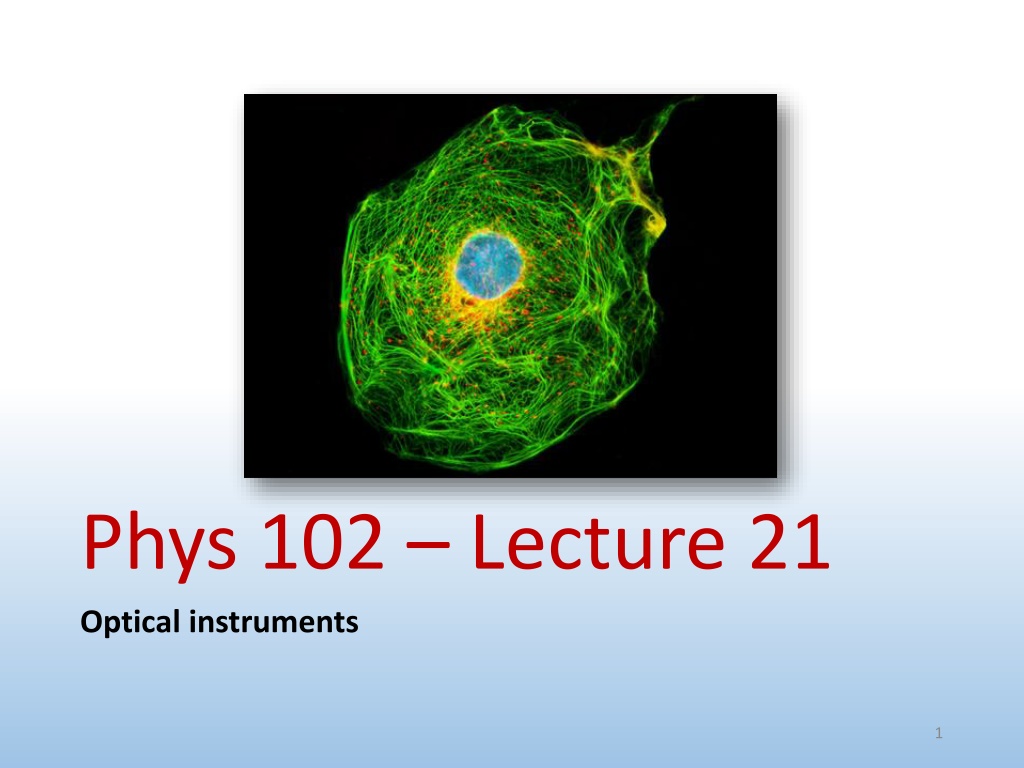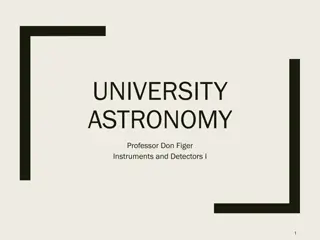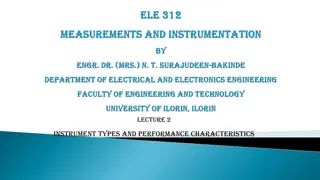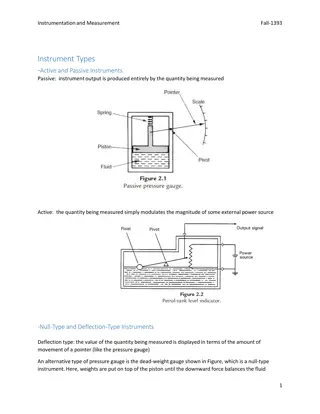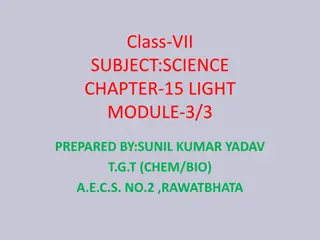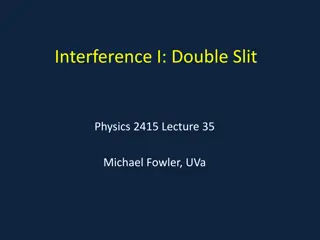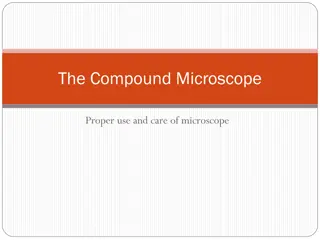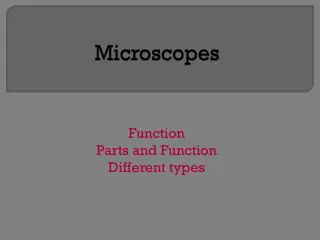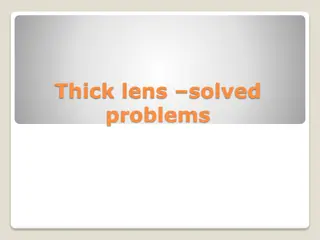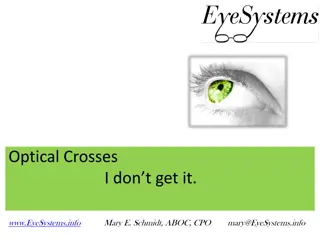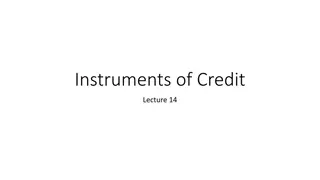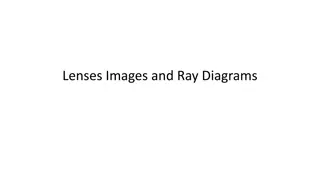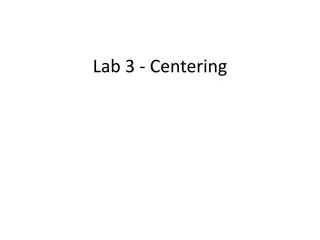Understanding Optical Instruments: Lenses, Images, and Magnification
Discover how combinations of lenses form images, explore thin lens equations and magnification principles, learn about compound microscopes, and understand the limits to resolution including spherical and chromatic aberrations and dispersion effects in this informative lecture on optical instruments.
Uploaded on Oct 05, 2024 | 0 Views
Download Presentation

Please find below an Image/Link to download the presentation.
The content on the website is provided AS IS for your information and personal use only. It may not be sold, licensed, or shared on other websites without obtaining consent from the author. Download presentation by click this link. If you encounter any issues during the download, it is possible that the publisher has removed the file from their server.
E N D
Presentation Transcript
Phys 102 Lecture 21 Optical instruments 1
Today we will... Learn how combinations of lenses form images Thin lens equation & magnification Learn about the compound microscope Eyepiece & objective Total magnification Learn about limits to resolution Spherical & chromatic aberrations Dispersion Phys. 102, Lecture 21, Slide 2
CheckPoint 1.11.2: multiple lenses Image of first lens becomes object for second lens, etc... p.a. f1 f2 f2 f1 Lens 1 Lens 2 65% Lens 1 creates a real, inverted and reduced image of the object Lens 2 creates a real, inverted and reduced image of the image from lens 1 The combination gives a real, upright, reduced image of the object 52% DEMO Phys. 102, Lecture 21, Slide 3
Calculation: final image location Determine the final image location for the 2-lens system s = 18 cm do,2 di,2 p.a. f1 f2 f2 f1 do,1 di,1 3 cm Lens 2 Lens 1 3 cm 1 1 f 1 1 6 1 1 + = = 18 10 = = 8cm d d s d = = ,1 ,2 ,2 i o o d d 15 10 ,1 1 ,1 i o 1 1 f 1 1 3 1 8 1 = Diagram should agree! 4.8cm id = = = ,2 d d 4.8 ,2 2 ,2 i o Phys. 102, Lecture 21, Slide 4
Calculation: final magnification Determine the final image size for the 2-lens system ho,1 hi,2 p.a. f1 f2 f2 f1 3 cm Lens 2 Lens 1 3 cm h h h h h h ,1 ,2 ,2 i i i = = = = m m m h tot o m h =+ =+ 0.4 6 2.4cm 1 2 tot ,2 ,2 i ,1 ,2 ,1 o o o Upright, reduced image d d d d 10 15 4.8 8 ,1 ,2 i i = = = + 0.4 ,1 ,2 o o Phys. 102, Lecture 21, Slide 5
ACT: CheckPoint 1.3 Now, the second converging lens is placed to the left of the first lens image. p.a. f1 f2 f2 f1 2 Lens 1 Which statement is true? A. Lens 2 has no object B. Lens 2 has a real object C. Lens 2 has a virtual object 32% Object after lens 2 is virtual: do,2 < 0 Image still forms but rays seem to originate from point after lens 2 30% 38% Phys. 102, Lecture 21, Slide 6
ACT: CheckPoint 1.4 Now, the second converging lens is placed to the left of the first lens image. p.a. f1 f2 f2 f1 2 Lens 1 1 1 f 1 = What is the image formed from lens 2? A. There is no image B. Real C. Virtual 31% d d ,2 2 ,2 i o 33% 36% do,2 < 0, so di,2 > 0 Phys. 102, Lecture 21, Slide 7
Lens combination: summary f1 f2 ... ... f f2 do,1 di,1 do,2 di,2 Image of first lens becomes object of second lens, ... = 3... m m m m 1 2 tot di = distance image is from lens: > 0: real image (after lens) < 0: virtual image (before lens) do = distance object is from lens: > 0: real object (before lens) < 0: virtual object (after lens) f = focal length lens: > 0: converging lens < 0: diverging lens Watch your signs! Phys. 102, Lecture 21, Slide 8
Compound microscope A compound microscope is made up of two converging lenses Eyepiece (ocular) Acts as a magnifying glass fe Body tube Tube length L = distance between focal points L Objective Creates real, enlarged image of sample object fo fo DEMO Sample Phys. 102, Lecture 21, Slide 9
Microscope ray diagram Total image magnification: d L f = = near f M M m tot e o e o Eyepiece (ocular) Eyepiece creates virtual, upright image at d fe = near f M Recall Lect. 20 e e Object just past objective focal pt. creates real, inverted image at eyepiece focal pt. d d f d i o o d f d L + L f 1 i 1 i 1 = + = = o 1 m o f o o o d d L f fo = = i m o Objective o o fo Phys. 102, Lecture 21, Slide 10 Sample
ACT: Microscope eyepiece The magnification written on a microscope eyepiece assumes the user has normal adult vision 10 means Me = 10 d = near f M e e Magnification In normal vision dnear = 25 cm d f M 25 10 = = = near 2.5cm e e What is the focal length of a 10 eyepiece? A. fe = 2.5 cm B. fe = 10 cm C. fe = 25 cm Phys. 102, Lecture 21, Slide 11
ACT: Microscope objective A standard biological microscope has a 160 mm tube length and is equipped with a 40 objective Tube length 40 means mo = 40 L f = m o o 160 40 of = = 4mm Magnification What is the focal length of the objective? A. fo = 4 mm B. fo = 8 mm C. fo = 16 mm Phys. 102, Lecture 21, Slide 12
Modern microscope objectives Most modern objectives are infinity corrected Finite system Infinite system Eyepiece Intermediate image Extra tube lens creates intermediate image Objective creates image at ; rays are || Objective Infinite system allows filters to be inserted in optical path without affecting image Phys. 102, Lecture 21, Slide 13
Calculation: Angular size A microscope has a 10 eyepiece and a 60 objective. How much larger does the microscope image appear to our eyes? = = mic M M m 600 = tot e o unaided At a near pt. of 25 cm, a 2- m bacterium has angular size to an unaided eye of: h d 6 2 10 0.25 o 6 = 8 10 rad = unaided near Bacillus subtilis In the microscope the angular size is: 6 3 = 600 8 10 = 4.8 10 rad mic Equivalent to a 600 2 m = 1.2 mm object at 25 cm What limits the resolution of a light microscope? Phys. 102, Lecture 21, Slide 14
Aberrations Aberrations are imperfections relative to ideal lens Spherical: rays hitting lens at different points focus differently Hubble space telescope Chromatic: rays of different color focus differently White light Where do chromatic aberrations come from? DEMO Phys. 102, Lecture 21, Slide 15
Dispersion The index of refraction n depends on In glass, nblue > ngreen > nred In prism, blue < green < red DEMO red i green blue White light Prism Blue light gets deflected more = = = sin sin sin sin n blue n n n blue green green red red i i Phys. 102, Lecture 21, Slide 16
CheckPoint 2.1: Rainbows Dispersion in water droplets create rainbows i red Sunlight blue green Blue light gets deflected more In water, nblue > ngreen > nred Red rays from higher droplet, blue rays from lower droplet reach eye 53% See a rainbow with red on top, blue on the bottom Phys. 102, Lecture 21, Slide 17
Double rainbow Second rainbow created from second reflection inside droplet. Second reflection reverses pattern LIKE SO! Double rainbow Phys. 102, Lecture 21, Slide 18
ACT: Dispersion A diverging lens made of flint glass has nred = 1.57, nblue = 1.59. Parallel rays of white light are incident on the lens. nblue > nred Blue light gets deflected more ? Which diagram best represents how light is transmitted? A. B. C. Phys. 102, Lecture 21, Slide 19
Ultimate limit of resolution One can play clever tricks with combinations of lenses to compensate for spherical and chromatic aberrations Ultimately, even with ideal lenses resolution of light microscope is limited to ~ of light (~500 nm) Bacillus subtilis We won t understand why using ray picture of light; we have to treat light as a wave again Ray optics works for objects >> Next two lectures! Phys. 102, Lecture 21, Slide 20
Summary of todays lecture Combinations of lenses: Image of first lens is object of second lens... The compound microscope Objective forms real image at focal pt. of eyepiece Eyepiece forms virtual image at Limits to resolution Spherical & chromatic aberrations Dispersion Diffraction limit next week! Watch signs! Phys. 102, Lecture 21, Slide 21
